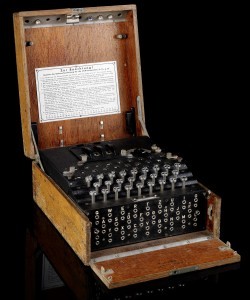British experts had already broken many of the Enigma codes for the Western front. Enigma was the Germans’ most sophisticated coding machine, necessary to secretly transmitting information. The Enigma machine, invented in 1919 by Hugo Koch, a Dutchman, looked like a typewriter and was originally employed for business purposes. The Germany army adapted the machine for wartime use and considered its encoding system unbreakable. They were wrong. The Brits had broken their first Enigma code as early as the German invasion of Poland and had intercepted virtually every message sent through the occupation of Holland and France. Britain nicknamed the intercepted messages Ultra.
Now, with the German invasion of Russia, the Allies needed to be able to intercept coded messages transmitted on this second, Eastern, front. The first breakthrough occurred on July 9, regarding German ground-air operations, but various keys would continue to be broken by the Brits over the next year, each conveying information of higher secrecy and priority than the next. (For example, a series of decoded messages nicknamed “Weasel” proved extremely important in anticipating German anti-aircraft and antitank strategies against the Allies.) These decoded messages were regularly passed to the Soviet High Command regarding German troop movements and planned offensives, and back to London regarding the mass murder of Russian prisoners and Jewish concentration camp victims.
Ask me anything
Explore related questions






